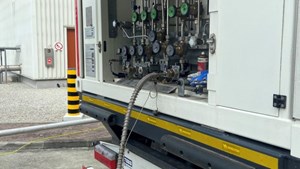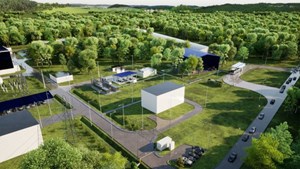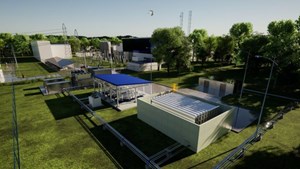News
Polenergia conducts the first H2 co-combustion tests in Poland
Polenergia has conducted the first hydrogen co-combustion tests in Poland. The tests, which took place in Podkarpacie, were successful. The largest Polish private energy group has also received a building permit for the H2HUB Nowa Sarzyna hydrogen project. The heart of the project is an electrolyzer for the production of green hydrogen with a capacity of 5 MW. - Our goal is to use green hydrogen for emission-free transport and greening of heat, and in the longer term - electricity. In Polenergia, business development goes hand in hand with the introduction of innovations that can change the face of the entire energy sector in Poland, - says Iwona Sierżęga, Member of the Management Board of Polenergia S.A.
The first hydrogen co-combustion tests in Poland with natural gas were conducted at the Nowa Sarzyna Cogeneration Plant (NSCP) belonging to Polenergia. They were conducted in one of the gas turbines with a capacity of approx. 40 MW. This is a breakthrough event for NSCP, especially since the tested turbine was not originally designed as “Hydrogen Ready”.
“Polenergia is conducting a number of hydrogen projects, the most advanced of which is H2HUB Nowa Sarzyna. Our goal is to produce green hydrogen. For the needs of industry, zero-emission transport, greening of heat, and in the longer term - also the generation of clean electricity. In Polenergia, business development goes hand in hand with the introduction of innovations that can change the face of the entire energy sector in Poland. We are guided by the overriding goal - zero emission, no later than 2040,” said Iwona Sierżęga, Member of the Management Board of Polenergia S.A.
The aim of Polenergia’s activities was to achieve a 10% share of hydrogen in the fuel, but during the tests an impressive result was achieved – the maximum hydrogen flow was 1,835 Nm³/h, which corresponded to a volumetric hydrogen concentration of 15%.
“We want to green the energy produced in the gas-steam block. The first necessary step was to implement the technology of mixing natural gas with hydrogen in a constant, stable composition and safe, fully controlled combustion of this mixture in a gas turbine, not factory-prepared for such a process. Achieving this stage opens the way to greening not only the production of electricity, but also heat energy. The next goal will be to increase the share of hydrogen in the fuel. This is a long-term process, also dependent on market conditions,” said Mirosław Rokicki, Technical Director and Member of the Management Board of Polenergia Elektrociepłownia Nowa Sarzyna (NSCP).
The tests were carried out using grey hydrogen, delivered by battery trucks. Ultimately, green hydrogen, produced in the electrolysis process from renewable energy, will be able to be supplied from the installation built in Nowa Sarzyna.
The following companies were also involved in hydrogen co-combustion tests at the Nowa Sarzyna Cogeneration Plant: Thomassen Energy, Bilfinger Tebodin, Biproraf, Promont, Valmet and Linde.
The Office of Technical Inspection was involved in the process of developing and implementing the necessary hydrogen supply installations, as well as adapting existing devices in the fuel system for this purpose.
The production of green hydrogen is an element of Polenergia’s strategy. The Group, which is one of the leaders in renewable energy in Poland, is conducting an advanced program to develop the production of this raw material.
Its elements include the H2Silesia project, a large-scale green hydrogen factory in Upper Silesia with a capacity of approx. 105 MW, and the H2HUB Nowa Sarzyna project located in the NSCP. Polenergia is also developing further hydrogen projects.
The H2HUB Nowa Sarzyna project with a capacity of 5 MW has just obtained a decision on a building permit for an installation for the production and filling of green hydrogen.
“This is the first decision issued for this type of project in Polenergia and a key step that brings us much closer to implementing the project. At the same time, our H2HUB Nowa Sarzyna project has reached a milestone in the construction of an electrolyzer, which has just passed factory tests. The electrolyzer is the heart of the hydrogen production node. A key element that will enable the production of hydrogen using water and the green energy we produce,” said Emilia Makarewicz, Director of Hydrogen Project Development at Polenergia.
Hystar AS, the supplier of green hydrogen production technology for the H2HUB Nowa Sarzyna project, has completed factory tests of all eight electrolyzer stacks. The stacks are the main process elements of the electrolyzer, precisely made using iridium and platinum.
The finished stacks have been transported to a plant near Gdańsk, where they will be connected to the rest of the electrolyzer elements.
The H2HUB Nowa Sarzyna project, which is in an advanced stage of development, has received funding from the National Fund for Environmental Protection and Water Management (NFOŚiGW).




